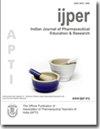Stability Indicating Reverse Phase-High Performance Liquid Chromatography Method for Simultaneous Estimation of Cabotegravir and Rilpivirine
IF 0.8
4区 医学
Q3 EDUCATION, SCIENTIFIC DISCIPLINES
Indian Journal of Pharmaceutical Education and Research
Pub Date : 2023-08-23
DOI:10.5530/ijper.57.3s.87
引用次数: 0
Abstract
Background: For the estimation of cabotegravir and rilpivirine in the bulk and pharmaceutical dosage form, a stability-indicating reverse-phase high-performance liquid chromatography method was developed and validated using an inertsil C 18 (150 x 4.6 mm, 5 µm) column. At a flow rate of 1.0 ml/min, a mobile phase containing a mixture of 0.01N ammonium acetate buffer (pH 3) and acetonitrile (65:35, v/v) was passed over the column. The column temperature was set at 30°C. A photodiode array detector was used at the wavelength of 257 nm. Results: Retention times of cabotegravir and rilpivirine were found to be 2.250 min and 2.823 min, respectively. The calibration curves were linear over the concentration range of 10-60 µg/ml and 15-90 µg/ml for cabotegravir and rilpivirine, respectively with a correlation coefficient ( R 2 ) of 0.999. The percent relative standard deviation (% RSD) for precision and robustness studies was found to be < 2%. The mean % recovery was obtained as 100.71 % and 100.01 % for cabotegravir and rilpivirine, respectively. The degradation during stability studies was more in the presence of oxidative conditions. Conclusion: The developed method was found to be simple, rapid, and economical and can be applied successfully for simultaneous estimation of cabotegravir and稳定性指示反相高效液相色谱法同时测定卡波特韦和利匹韦林的含量
背景:为了估计散装和药用剂型中的卡波特韦和利匹韦林,建立了一种稳定性指示的反相高效液相色谱法,并使用inertsil c18 (150 x 4.6 mm, 5µm)柱进行了验证。以1.0 ml/min的流速,将含有0.01N醋酸铵缓冲液(pH 3)和乙腈(65:35,v/v)混合物的流动相通过色谱柱。柱温设定为30℃。采用波长为257 nm的光电二极管阵列探测器。结果:卡波特韦和利匹韦林的滞留时间分别为2.250 min和2.823 min。cabotegravir和rilpivirine在10 ~ 60µg/ml和15 ~ 90µg/ml浓度范围内均呈线性,相关系数(r2)为0.999。发现精确度和稳健性研究的相对标准偏差(% RSD)百分比< 2%。卡波特韦和利匹韦林的平均回收率分别为100.71%和100.01%。在稳定性研究中,氧化条件下的降解更多。结论:所建立的方法简便、快速、经济,可成功地用于头孢替他韦和头孢替他韦的同时测定
本文章由计算机程序翻译,如有差异,请以英文原文为准。
求助全文
约1分钟内获得全文
求助全文
来源期刊
CiteScore
1.40
自引率
0.00%
发文量
227
审稿时长
>12 weeks
期刊介绍:
The official journal of Association of Pharmaceutical Teachers of India (APTI) and is being published since 1967. IJPER, a quarterly publication devoted to publish reviews and research articles in pharmacy and the related disciplines of Pharmaceutical education. It mainly covers the articles of special interest, covering the areas of Pharmaceutical research, teaching and learning, laboratory innovations, education technology, curriculum design, examination reforms, training and other related issues. It encourages debates and discussions on the issues of vital importance to Pharmaceutical education and research. The goal of the journal is to provide the quality publications and publish most important research and review articles in the field of drug development and pharmaceutical education. It is circulated and referred by more than 6000 teachers, 40,000 students and over 1000 professionals working in Pharmaceutical industries, Regulatory departments, hospitals etc.

 求助内容:
求助内容: 应助结果提醒方式:
应助结果提醒方式:


